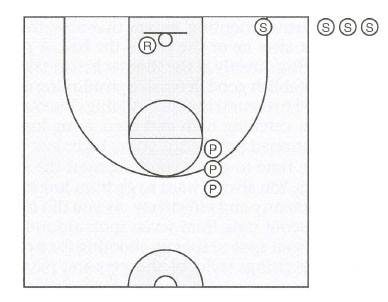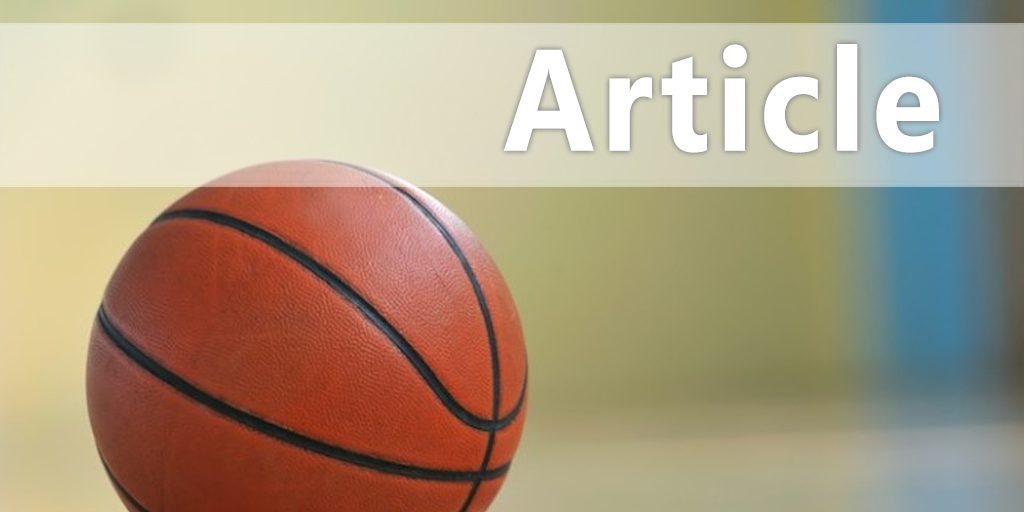| Mid Range Shooting Drills
Originally Published in: Basketball Shooting - Human Kinetics
A final note on drilling the midrange jump shot: you can add faking elements. For example, say on Monday you practice a one-two-step, straight-on midrange shot in your spinouts drill. On Tuesday, perform the same drill, but add a shot fake. On Wednesday, add a jab step. On Thursday, jab, then shot-fake, then shoot. The proper technique for executing jabs and shot fakes is covered in chapter 8. The point is that when you are drilling, whether by yourself or with a partner, it should never become a boring process because there are so many skills to hone. In the basic midrange shot, you have the opportunity to master variations of the same weapon that will leave defenders frustrated and opposing coaches scratching their heads over how they might shut you down. Spinouts This is a drill that you can use when alone to simulate a catch-and-shoot opportunity. Start in a balanced athletic stance and spin the ball toward yourself so that it bounces off the ground and into your shot pocket. Time the spin and take a one-two step into the jump shot. You should freeze your follow-through until the ball hits the floor, allowing yourself to reinforce and ingrain this habit. Many players have a tendency to drop the balance hand or both hands on the follow-through. If you drop the hands quickly in practice, you will drop them more quickly in the game. Make sure your spinout never comes above your waist. Start low and stay low until you pull up into your shot. By spinning out low, you will eliminate the high-low-high shot, in which you catch the ball and bring it down first, resulting in a negative motion and allowing a defender to get a hand on the ball, as well as taking more time to get the shot off. Perform this drill 10 times from a single spot. Record the number of makes and shoot from seven spots, circling around the basket during any given routine. Once you've become comfortable with your midrange technique, progress from shooting 10 to actually making 10. If making 10 is a struggle, begin by making 5 and work your way up. The point I want to drive home here is that when great shooters practice, they go for makes and not takes. Another way to practice is to shoot strings style from the seven spots and see how many you can make in a row from each spot. Mix it up and keep it competitive for yourself. Be creative. Partner Shooting In this drill, players are paired up. You can perform this drill in a two-person workout or use multiple baskets for an entire team of players. One player acts as the shooter and starts in a balanced athletic stance. The shooter calls for the ball and the other player passes the ball from under the basket. The shooter takes a one-two step to meet the ball, catches it, sights the target, and shoots the ball. The shooter should strive to catch the ball in a balanced position and to land after the shot in a balanced position while freezing the follow-through. The shooter shoots from seven spots around the basket. The shooter can shoot in the same manner as he or she would in spinouts, either going for a certain number of makes or shooting strings style. Players can alternate shots and follow up their misses with a weak-handed layup. The important things to emphasize are that the shooter should use correct fundamental technique and the passer should deliver good passes. If you never practice throwing good passes in practice, you will never be able to throw good passes in games. This drill is like partner shooting, except that now, the passer will close out on the shooter after he or she passes the ball. A proper closeout is executed by sprinting directly at the shooter before taking several short, choppy steps to establish good defensive positioning and mirroring the ball with your hand to contest the shot. Adding closeouts from the passer will stop you from catching high and then going low for a high-lowhigh shot. As mentioned previously, going high, low, then high allows the defender more time to get to you to contest the shot or even stop you from shooting. You always want to go from low to high so you can shoot the ball efficiently and effectively. As you did in shooting with a partner, shoot closeout style from seven spots around the basket. Also, you can advance from spot to spot by shooting for a certain number of makes or shooting strings style, or shooters and passers can alternate shots and positions. Divide players into groups of at least seven. The group includes one rebounder, three or more passers (all with balls), and three or more shooters. As shown in figure 5.6, players line up in a triangle formation with the rebounder (shown as R in the diagram) under the hoop, the passers (shown as P in the diagram) on an elbow, and the shooters (shown as S in the diagram) along the baseline. The first passer in line delivers a pass to the shooter's shot pocket. The first shooter in line is in a shot-ready position and calls for the ball, takes a one-two step to the ball and shoots the jump shot, freezing the follow-through. The rebounder gets the ball out of the net. Regardless of whether it's a make or a miss, the rebounder tries not to let the ball hit the floor. After getting the ball, the rebounder speed dribbles out to the passing line with the weak hand. The passer moves to the end of the shooting line, and the shooter becomes the next rebounder.  This is a continuous drill that allows a group of people to perform a lot of repetitions in a short amount of time. You can also change the pass from baseline to elbow and reverse the line rotation to practice shooting from another spot. Be sure to drill triangle passing on both sides of the court. I especially like this drill because the passing angle is more gamelike. In spinouts or partner shooting, the pass comes from under the basket, which is ideal for working on a one-two-step, straight-on shot. However, in a game, passes more often come from an angle. This drill allows players to simulate those types of passes while working on the same one-two step mechanics. You can keep the drill competitive by going for a certain number of team makes or having players track their own personal makes and having the losers run sprints. Many coaches like to put two minutes on the clock and run this drill from four spots - both corners and both elbows. Transition Jump Shot This drill teaches players how to make the transition from a sprint to being on balance for the jump shot. Divide players into groups of at least seven. The group includes one rebounder, three or more passers, all with balls, and three or more shooters. Shooters start at midcourt at either sideline and inbounds, and passers line up in the corner on the same side of the court as the shooters. To begin, the first shooter in line takes long strides and then shorter steps before timing the one-two step into the jump shot. It is important that the shooter calls for the ball, especially now that he or she is moving at a high rate of speed. When the shooter calls for the ball, the passer delivers the ball and tries to hit the shooter as he or she strides into the one-two step. The shooter receives the ball and takes the shot. The rebounder tries not to let the ball hit the floor, and after getting the ball, he or she dribbles to the corner where the passers are positioned. The first shooter now becomes the rebounder and the passer takes a position at the end of the shooting line. When practicing this drill with a group of players, make it competitive by going for total makes, or have the players compete against one another based on individual makes. You can also time this drill. Stop and Pop This drill helps players improve their pull-up jump shot off the dribble. It can be done individually or with an entire team. Players begin at either half-court or full court and use a speed dribble up the court. The player stops on a dime to shoot a 12- to 15-foot (3.6-4.5 m) jump shot. Perform this 10 times with each hand. When going full court, the shooter goes down to one end using the right hand and comes back using the left. More advanced players can work on using different types of dribble moves, incorporating a crossover dribble or an inside-out dribble before stopping and popping.
|






